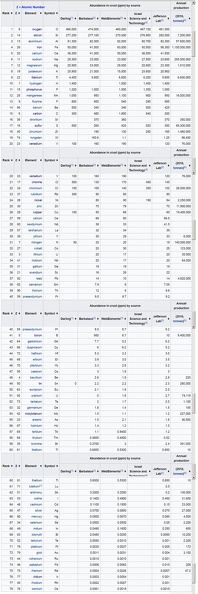Abundance of Elements -Evidence of Ancient Impacts
Jan 14, 2019 4:59:56 GMT -5
rockjunquie, fernwood, and 4 more like this
Post by 1dave on Jan 14, 2019 4:59:56 GMT -5
When Earth began 4.5 billion years ago, it was so hot it became a "differentiated planet" meaning the heaviest elements sank in weight order to the center and a crust was formed consisting of the lightest elements with only very small amounts of the heavier elements.
Over billions of years as the continents gently bobbed up and down sediments accumulated varying from sandstone to limestone to shale to salt beds to mud and back again.
The layers consisted predominantly of the 16 most common elements left in the earth’s crust - in descending percent amounts they are:
Oxygen 46.7%, silicon 27.7%, aluminum 8.1%, iron 5.1%, calcium 3.7%, sodium 2.8%, potassium 2.6%, magnesium 2.1%, titanium 0.62%, hydrogen 0.14%, phosphorus 0.13%, manganese 0.9%, fluorine 0.29%, barium 0.05%, carbon 0.094%, and strontium 0.037%.
Those 16 make up 99.9% of all mud. Anything beyond them is highly unusual.
www.daviddarling.info/encyclopedia/E/elterr.html

A complete list is here.
en.wikipedia.org/wiki/Abundance_of_elements_in_Earth%27s_crust

From the beginning the surface has been bombarded from outer space by asteroids, comets, and meteors of varying compositions,
creating many unique and valuable mineral locations.
www.popsci.com/60-tons-cosmic-dust-fall-earth-every-day
60 X 365 days = 21,900 tons /year X 1 million years = 21,900,000, tons = a lot of new soil!
Over billions of years as the continents gently bobbed up and down sediments accumulated varying from sandstone to limestone to shale to salt beds to mud and back again.
The layers consisted predominantly of the 16 most common elements left in the earth’s crust - in descending percent amounts they are:
Oxygen 46.7%, silicon 27.7%, aluminum 8.1%, iron 5.1%, calcium 3.7%, sodium 2.8%, potassium 2.6%, magnesium 2.1%, titanium 0.62%, hydrogen 0.14%, phosphorus 0.13%, manganese 0.9%, fluorine 0.29%, barium 0.05%, carbon 0.094%, and strontium 0.037%.
Those 16 make up 99.9% of all mud. Anything beyond them is highly unusual.
www.daviddarling.info/encyclopedia/E/elterr.html

A complete list is here.
en.wikipedia.org/wiki/Abundance_of_elements_in_Earth%27s_crust

From the beginning the surface has been bombarded from outer space by asteroids, comets, and meteors of varying compositions,
creating many unique and valuable mineral locations.
www.popsci.com/60-tons-cosmic-dust-fall-earth-every-day
Until now, scientists didn't know how much of this cosmic dust was gathering on Earth (though they know rather a lot about how much is up in space). Researchers guessed that anywhere between 0.4 and 110 tons of the star stuff entered our atmosphere every day--that's a pretty wide range. But a recent paper took a closer look at the levels of sodium and iron in the atmosphere using Doppler Lidar, an instrument that can measure changes in the composition of the atmosphere. Because the amount of sodium in the atmosphere is proportional to the amount of cosmic dust in the atmosphere, the researchers figured out that the actual amount of dust falling to the earth is along the lines of 60 tons per day.
60 X 365 days = 21,900 tons /year X 1 million years = 21,900,000, tons = a lot of new soil!












